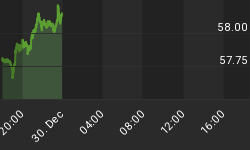In a New York minute everything can change
In a New York minute, lying here in the darkness
I hear the sirens wail, somebody going to emergency.
New York Minute by Don Henley. 1989.
Chances of a 25-bp rate hike later this month fell to 48% from 68% after the payrolls, increasing speculation that the FOMC will pause. But as we stated earlier this week, the Fed's increased importance vis-à-vis the inflationary repercussions of the falling dollar maintain our inclination towards a June hike. Of the major factors that would cause us to revise this forecast are a retreat in the May core CPI (to no higher than 0.2%) and core PCE price index (to no higher than 2.0% y/y) as well as another 4-5% decline in the S&P 500, which would add total losses to 10% from the year's 1326 high.
Indeed, today's payrolls underscore the Fed's growth-inflation dilemma. And although chances of further data weakness this month could bolster the argument of the doves, the Fed's preoccupation with the downside growth risks remains outweighed by their inflationary worries. Although 10-year yields are now equal to the 5.00% fed funds rate -- a sign of a pause -- the yield has yet to push higher towards the 5.10-15% level on comments by hawkish Fed members and by the remaining inflation data.
US non-farm payrolls rose by 75K in May from a revised increase of 126K in March, while the unemployment rate dipped to 4.6%. Average hourly earnings growth slowed to 0.1% from 0.6%. The revisions for the April and March payrolls totaled a net decrease of 37K.
Our decision to reduce our forecast from 150K to 110K yesterday was founded on the increase in the weekly jobless claims for May and the April decline in construction spending (first in a year). We argued that the decline in April construction spending was expected to filter through further slowdown in construction jobs.
Indeed, construction jobs rose by 1k, with the 3-month average falling to 6K, the lowest since April 2003, fortifying the argument that the real estate slowdown is not only manifesting itself via cooling home sales, but also via the construction of residential homes.
Manufacturing employment reverted to its old dismal ways, shedding 14K jobs after a rare 4-month string of job creation between October and January, which was a result of post Katrina-Rita Hurricanes rebuilding.
But the job losses were not only confined to the "old economy" manufacturing sector. Services employment added 85K jobs in May after 81K in April, dragging the 3-month average to 111K, the lowest level since November.

The damage on the dollar was exacerbated by the weaker than expected 0.1% reading in average hourly earnings, the lowest since August. Although the year-on-year slipped to 3.7% from 3.8%, it was the second highest in 5 years.
The 4.6% unemployment rate was the lowest since summer 2001 may carry a good tune to it in this weekend's headlines, but markets are not only well aware of the advantages of an eroding labor force on the jobless number. The realities of the establishment survey show the undeniable reality of slowing job creation after 400-bps of tightening.
















